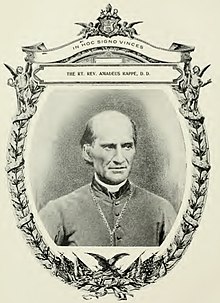Louis Amadeus Rappe
|
The Right Reverend Louis Amadeus Rappe D.D. |
|
|---|---|
| Bishop of Cleveland | |
 |
|
| Church | Roman Catholic Church |
| Archdiocese | Cincinnati |
| Diocese | Cleveland |
| See | Cleveland |
| In office | October 10, 1847–August 22, 1870 |
| Predecessor | Office Created |
| Successor | Richard Gilmour |
| Orders | |
| Ordination | March 14, 1829 by Hugues de la Tour d'Auvergne-Lauragais |
| Consecration | October 10, 1847 by John Baptist Purcell |
| Personal details | |
| Born |
February 2, 1801 Audrehem, Pas-de-Calais, France |
| Died | August 9, 1877 (aged 76) St. Albans (town), Vermont, USA |
| Buried | Cathedral Resurrection Chapel |
| Nationality | French |
| Previous post | Priest of the Diocese of Cincinnati (1839–1847); Priest of the Diocese of Boulogne (1829–1839) |
| Motto | In hoc signo vinces |
Louis Amadeus Rappe (February 2, 1801 – August 9, 1877) was a French-born bishop of the Roman Catholic Church. He served as Roman Catholic Bishop of Cleveland from 1847 to 1870.
The son of peasants, Rappe was born in Audrehem, Pas-de-Calais, to Eloi and Marie Antoinette (née Noël) Rappe. He was one of ten children and labored in the fields until October 1820, when he entered the College of Boulogne (then under Benoit Haffreingue). After graduating in 1826, Rappe entered the seminary of Arras and was later ordained to the priesthood by Bishop (later Cardinal) Hugues de la Tour d'Auvergne-Lauragais on March 14, 1829. He then served as pastor of Wismes until 1834, when he became chaplain to the Ursuline monastery in Boulogne.
In 1839 he accepted an invitation from Bishop John Baptist Purcell to join the Diocese of Cincinnati, Ohio, in the United States, arriving there in October 1840. He was sent to Chillicothe to learn English from the scholar, William Marshall Anderson. Purcell named him pastor of St. Francis de Sales Parish in Toledo. Rappe ministered to the Catholic laborers on the Miami and Erie Canal and the settlers along the Maumee River; his unofficial parish limits extended from Toledo to the Indiana border and as far south as Allen County. He was a strong temperance advocate. To educate the children of his flock, he established a branch of the School Sisters of Notre Dame, building a convent and school for them. Having hitherto labored by himself, he eventually received the Rev. Louis De Goesbriand as an assistant in 1846.
...
Wikipedia
